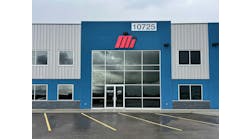National Instruments celebrated the arrival of Labview 8.5, the latest version of its graphical system design platform for test, control and embedded system development, at NIWeek in Austin, Texas, at the beginning of August.
The conference is an annual opportunity for users to mingle with NI’s R&D team and learn from their peers about successful applications of NI technology.
During his keynote presentation, Dr. James Truchard, president, CEO and co-founder of NI, touted the new features of his company’s flagship platform product to a reportedly record crowd of more than 2,400 users and scholars.
Adam Suchko.
Chief engineer at Engineering Concepts Unlimited
“You come to NIWeek with expectations of state-of-the-art stuff, good food and company and maybe a free T-shirt or something,” says Adam Suchko, chief engineer at Engineering Concepts Unlimited, an electrical control equipment manufacturer in Fishers, Ind. “This year we all came away with something even better—the hope that multicore processing will be handled in the same way programmers have been writing all along in Labview.”
Nearly 10 years of research went into the multithreading technology, according to NI, that allows Labview 8.5 to simplify multicore application development with its parallel dataflow language. And while the release of Labview’s latest iteration was met with great exuberance from the conference attendees, few were surprised by any of the developments.
“Of all the stuff that I saw, most were evolutionary, building on themes established in previous years,” says Stuart McFarlane, vice president at Viewpoint Systems, an automated measurement systems builder in Rochester, N.Y. “It was good to see the maturing of several of the product lines.”
Users were ecstatic to see the next generation of NI applications, particularly because many of them were created as a result of user feedback. “I was excited by Jeff Kodosky’s keynote about system design," continues McFarlane. “I had discussed this topic with him several years ago and can see that the approach that they are working on will deliver on a very difficult problem. In my role, design work and proposals that can be handed off to the rest of group will be a huge step forward in our productivity. I’m not sure if I will see a mature tool in this area before I retire, but my kids will be using this tool.”
The collaboration of developers and users at NIWeek is actually the annual culmination of an ongoing dialogue that allows face-to-face discussions.
“This was my fourth NI week, and I go every year to brush up on my Labview knowledge and hopefully learn something new,” says Jason Stallard, software engineer, advanced engineering—pre-product technology, at engine manufacturer Cummins in Columbus, Ind. His primary job is to support engineering efforts by developing and supporting in-vehicle data acquisition and logging systems as well as prototype sensor/actuator controls.
“While at NIWeek, I also take the opportunity to interface with the various NI developers to share how I use NI hardware and Labview, as well as get some early information on upcoming products,” he explains.
Something for Everyone
Different users came to the conference for different reasons. Dana Johnson, project manager at Life Cycle Engineering, an engineering services and technology provider in Charleston, S.C., was a submarine sonar man with the U.S. Navy and retired from the service in 1988. He became a think-tank consultant with a government contractor for four years before joining Life Cycle Engineering in 1992. “It’s not necessarily what you know that makes you a player in this business,” he explains. “It’s the application of what you know that counts.”
Johnson came to NIWeek with a colleague, “Buddy” Whetzel, looking to remain current with the technology and increase the company’s opportunities.
“We’re always trying to stay on top of PXI instrumentation, as we are presently engaged in a project for the Navy that is deep into this ever-evolving area,” he says. “And we found the gains in the RF community very interesting, as that is where we are looking to expand our capabilities next. NI is a leader in this effort, and we like to use their products whenever possible for the seamless integration into our unit, which cuts back tremendously on programming headaches. We have used Labview from the beginning of our project and have found that it lends itself nicely to intuitive innovations.”
Multicore Takes Center Stage
Still, the multicore processing was NI’s primary focus at this year’s conference.
“Engineers and scientists depend on continually improving PC processors, operating systems and bus technologies to drive increased performance in their measurement and control systems,” says NI’s Truchard. “With the shift toward multicore processors on the PC, Labview programmers benefit from a simplified graphical approach to multithreading.” The idea is to allow a single application to be divided into multiple threads, making it possible for users to run programs on multiple cores with little or no change to their applications.
“Now, I am not a big-time Labview programmer,” explains ECU’s Suchko. “But even I could see the writing on the wall. To achieve the programmability of multithreading in textual languages takes brains and thought. Labview makes it so you just draw two to four different process blocks on a screen and say, ‘Go.’”
FPGA Innovations & OPC Drivers
Joel Shapiro, group manager, network measurements, at NI, claims the beauty of Labview is that it allows FPGA programming by domain experts without needing to hire VHDL gurus. But users found their own FPGA innovations to crow about.
“A combined M-series DAQ card with FPGA front end speaks for itself in the ability to create a custom hardware/software approach to problems that would have to combine multiple cards before,” says Viewpoint Systems’ McFarlane. “And fixed point support in FPGA is finally being introduced. I will be evaluating this feature in the near future for higher performance closed loop systems.”
While there is unbridled curiosity in how the programmable FPGA market will play out, “the safety of a FPGA may make for some really cool and dependable products since it is a pure hardware solution,” continues Suchko. “Dr. T (Truchard) wants ‘Labview to the pin.’ He has a great vision there, and Labview FPGA seems to be the ticket.”
Labview is designed to allow users to integrate existing PLC-based industrial systems with more advanced programmable automation controllers (PACs), adding high-speed I/O and complex control logic to their industrial systems, including a new library of OPC drivers to expand industrial connectivity. “Mike Santori's presentation on the PAC platform got me excited,” says McFarlane. “That will open up many applications in the industrial market that are currently closed. It remains to be seen if NI will have enough connectivity options to really play in this area.”
For Those About to Design
Good news for those keen on taking the newest applications out for a test-drive: NI announced the formal launch of NILabs during the user conference. The online forum at www.ni.com/labs allows visitors to download prototype and beta products, try them out and offer feedback to the developers.
One new NI product that is about to be introduced is the smart camera, which runs Labview in real time on the CPU inside the camera.
“How about NI in the camera business?,” asks Suchko, who also instructs an engineering class at Cathedral High School in Indiana and is a FIRST Robotics mentor. He’s also worked as a staff R&D designer at RCA and taught at Purdue University. “NI is releasing their own smart camera that can handle basic vision and do live control work, including the demo they had running with a bottle inspector being operated by the camera itself, including a stepper motor. It looked at the bottle and rotated it to read the label. They said they might offer this as a package with VBAI 3.5 for less than $2,000. VBAI software is about $1,800 itself. It is very capable and fast. You can author complete inspection line stuff and even control some low-level I/O from the script you make. A really cool feature is the ability to programmatically change inspections on the fly from within the code itself. I think this is a killer sleeper product that NI seems not to push enough, but in my years of vision work it always appears to be a great bargain.”

Leaders relevant to this article:




